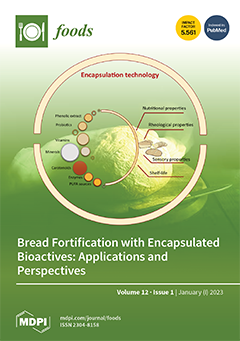Safe and health-beneficial citrus oils can be employed as natural preservatives, flavorings, antioxidants, and as antibacterial and antifungal agents in a wide variety of food products. In this research, using GC–MS methodology, the major volatile composition of
Citrus bergamia EO, obtained by hydro-distillation,
[...] Read more.
Safe and health-beneficial citrus oils can be employed as natural preservatives, flavorings, antioxidants, and as antibacterial and antifungal agents in a wide variety of food products. In this research, using GC–MS methodology, the major volatile composition of
Citrus bergamia EO, obtained by hydro-distillation, was determined to consist of limonen (17.06%), linalool (46.34%) and linalyl acetate (17.69%). The molecular fingerprint was obtained using FTIR spectroscopy. The antibacterial effect of
C. bergamia EO at different concentrations (0.5, 1, 2.5 and 5 µg/mL) was tested against different pathogen species (
Salmonella typhimurium, Bacillus cereus, Staphylococcus aureus, Escherichia coli, Listeria monocytogenes), based on disc diffusion assay. The in vitro antifungal activity of
C. bergamia EO oil against
Aspergillus niger and
Penicillium expansum was evaluated using agar disc diffusion assay. Clear inhibition zones were formed by
C. bergamia EO against selected species of pathogens. Almost all of the concentrations were revealed to have antifungal activity against selected fungal pathogens. The highest inhibition rate of
A. niger at 6 incubation days was 67.25 ± 0.35 mm with a 20 µL dose, while the growth in the control was 90.00 ± 0.00 mm. In addition, the highest inhibition rate of
P. expansum was 26.16 ± 0.76 mm with a 20 µL dose, while the growth was 45.50 ± 2.12 mm in the control fungus. A higher antifungal effect of
C. bergamia EO against
P. expansum was obtained. It was observed that the growth of fungi was weakened with increasing concentrations (5, 10, 15 and 20 µL dose) of
C. bergamia EO. Statistically significant (
p < 0.05) results were obtained for the antibacterial and antifungal effects of
C. bergamia EO. The findings from the research may shed light on the further use of
C. bergamia EO obtained from peels in innovative food engineering applications in order to maintain food quality, food safety, and food sustainability.
Full article






